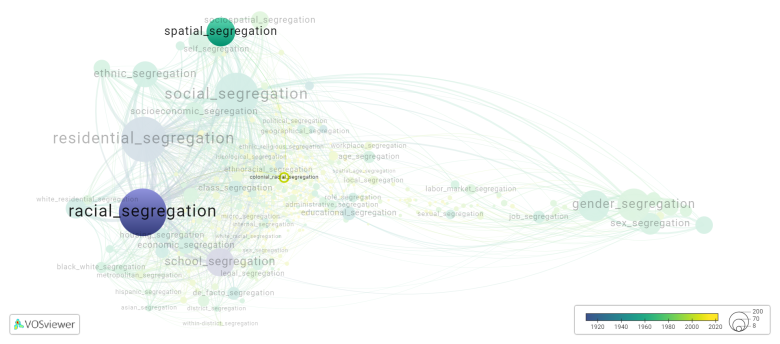Colonial racial segregation: Difference between revisions
(Creating page) |
(Creating page) |
||
| (6 intermediate revisions by the same user not shown) | |||
| Line 1: | Line 1: | ||
===== Date and country of first publication<ref>Date and country of first publication as informed by the Scopus database (December 2023).</ref>===== | |||
2012<br> | 2012<br> | ||
United States | United States | ||
===== Definition ===== | |||
Colonial racial segregation refers to the system of segregation based on race that was implemented during the colonial period. This system was primarily practiced by colonial powers, primarily European countries, in their colonies and territories across the world. | Colonial racial segregation refers to the system of segregation based on race that was implemented during the colonial period. This system was primarily practiced by colonial powers, primarily European countries, in their colonies and territories across the world. | ||
| Line 18: | Line 18: | ||
It is important to recognize and understand the historical context and impacts of colonial racial segregation in order to address and combat present-day racial inequalities and discrimination. | It is important to recognize and understand the historical context and impacts of colonial racial segregation in order to address and combat present-day racial inequalities and discrimination. | ||
==See also== | ==See also== | ||
==Related segregation forms== | |||
Colonial racial segregation is frequently discussed in the literature with the following segregation forms: | |||
[[racial segregation]], [[spatial segregation]] | |||
[[File:colonial_racial_segregation.png|780x780px]] | |||
This visualization is based on the study [[Segregation_Wiki:About| The Multidisciplinary Landscape of Segregation Research]]. | |||
For the complete network of interrelated segregation forms, please refer to: | |||
* [https://tinyurl.com/2235lkhw First year of publication] | |||
* [https://tinyurl.com/2d8wg5n3 Louvain clusters] | |||
* [https://tinyurl.com/223udk5r Betweenness centrality] | |||
* [https://tinyurl.com/244d8unz Disciplines in which segregation forms first emerged (Scopus database).] | |||
==References== | ==References== | ||
==Notes== | ==Notes== | ||
<references /> | <references /> | ||
{{NoteAI}} | {{NoteAI}} | ||
== | ==Colonial racial segregation appears in the following literature== | ||
Njoh A.J. (2012) Implications of spatial and physical structures for ICT as a tool of urban management and development in Cameroon. ''Habitat International'', ''36''(3), 343-351. Elsevier Ltd. | Njoh A.J. (2012). Implications of spatial and physical structures for ICT as a tool of urban management and development in Cameroon. ''Habitat International'', ''36''(3), 343-351. Elsevier Ltd.https://doi.org/10.1016/j.habitatint.2011.06.006 | ||
Latest revision as of 07:17, 16 October 2024
Date and country of first publication[1][edit | edit source]
2012
United States
Definition[edit | edit source]
Colonial racial segregation refers to the system of segregation based on race that was implemented during the colonial period. This system was primarily practiced by colonial powers, primarily European countries, in their colonies and territories across the world.
During colonialism, racial segregation was used as a means of maintaining and enforcing racial hierarchies and control over colonized populations. It reinforced the idea of racial superiority of the colonizers and the inferiority of the indigenous or colonized people.
In many colonies, racial segregation was institutionalized through various laws and policies. For example, in British colonies like South Africa and Rhodesia (now Zimbabwe), apartheid was implemented as a formal system of racial segregation. It allowed the government to legally enforce separation and discrimination against non-white populations, primarily Blacks.
Under apartheid, various racial groups were assigned different areas for living, education, and employment. Non-white individuals were subjected to restrictions on their movement, limited access to resources, and severe discrimination in various aspects of life.
Similarly, other colonial powers such as France, Belgium, and Portugal also practiced racial segregation in their colonies. This segregation was often based on the racial classification systems imposed by the colonizers, which categorized people into different racial groups.
Colonial racial segregation not only affected the daily lives and rights of non-white populations but also perpetuated long-lasting social, economic, and political inequalities. It resulted in the marginalization and disenfranchisement of non-white communities, as well as the ongoing legacy of racial tensions and injustices in many post-colonial societies.
It is important to recognize and understand the historical context and impacts of colonial racial segregation in order to address and combat present-day racial inequalities and discrimination.
See also[edit | edit source]
Related segregation forms[edit | edit source]
Colonial racial segregation is frequently discussed in the literature with the following segregation forms:
racial segregation, spatial segregation

This visualization is based on the study The Multidisciplinary Landscape of Segregation Research.
For the complete network of interrelated segregation forms, please refer to:
References[edit | edit source]
Notes[edit | edit source]
- ↑ Date and country of first publication as informed by the Scopus database (December 2023).
At its current state, this definition has been generated by a Large Language Model (LLM) so far without review by an independent researcher or a member of the curating team of segregation experts that keep the Segregation Wiki online. While we strive for accuracy, we cannot guarantee its reliability, completeness and timeliness. Please use this content with caution and verify information as needed. Also, feel free to improve on the definition as you see fit, including the use of references and other informational resources. We value your input in enhancing the quality and accuracy of the definitions of segregation forms collectively offered in the Segregation Wiki ©.
Colonial racial segregation appears in the following literature[edit | edit source]
Njoh A.J. (2012). Implications of spatial and physical structures for ICT as a tool of urban management and development in Cameroon. Habitat International, 36(3), 343-351. Elsevier Ltd.https://doi.org/10.1016/j.habitatint.2011.06.006
